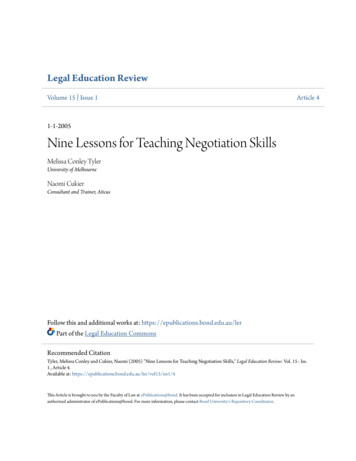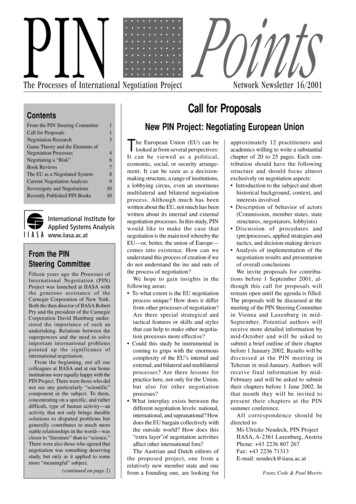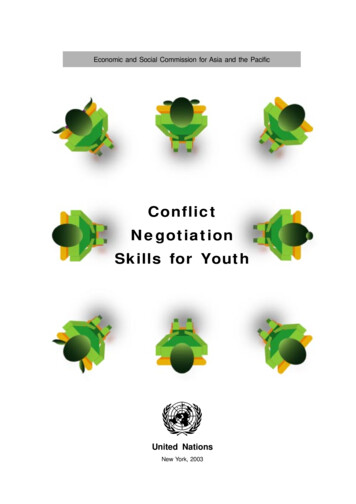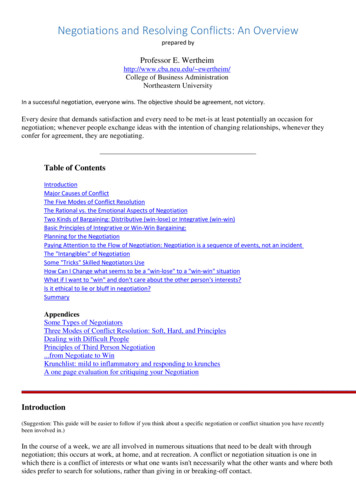
Transcription
advancing women in businessWORKBOOKDEVELOPING YOURNEGOTIATION SKILLS
CONTENTSAbout this workbook3Introduction to negotiationArt or skill?Key principles of negotiation457Section 1. Prepare thoroughly9Section 2. Negotiate an objective criteriaHave options and alternatives availableExercise communcation skillsHandle the discussion objectively10141415Section 3. Hurdles, challenges and counterproductivebehavioursSection 4. Group negotiations26Section 5. Your personal action plan28everywoman ExpertsFurther Reading233132www.everywoman.com2
About this workbook: why negotiation?ESTABLISHED IN 1999, everywoman providesleading edge products and services that advancewomen in business. Inspiring success andfulfilling potential is the backbone of what we do.By understanding the ever changing businessenvironment and our partners’ needs, we areable to provide leading edge products and prideourselves on offering an unbeatable service.Why negotiation?Negotiation is a skill we learn in childhoodand continue to practise throughout our lives.Mostly, we do it instinctively; applying whatwe know about the person we’re dealing within order to achieve our goals. When hurdlespresent themselves, we find ways around them.We mostly like to leave the other person feelinggood about what has happened, so that we cannegotiate with them again, another day.As adults, we buy cars and houses; negotiatewith tradespeople to do work in our homes, ourchildren to eat their greens and our cohabitersto do their share of chores! But somehow, whenwe stop to think about negotiation in a formalbusiness context – whether that’s wranglingover the terms of a vendor contract or askingour bosses for a higher salary, flexible workinghours or more resources to ease our workloads –many women in particular, research has shown,can seize up. Nerves kick in, an inner voice maysabotage our success, and the whole thing takeson an onerous quality. All of which can lead tofear, reluctance and avoidance of negotiation.At its worst, negotiation is viewed as a processby which two sides set out to win until one sideeventually surrenders. This can take a very longtime and lead to stalemate and bad feeling. In fact,negotiation done well is a thoughtful explorationof the positions each side hold. The aim is tofind a mutually acceptable compromisebetween the two positions, both getting asmuch of what they want as possible. Eachparty’s position is rarely as far apart as itseems – there are usually many points ofcommon interest.Ideally, a negotiation will produce a solutionabout which both sides feel comfortable; oftendescribed as a win:win position. The solutionwill be sensible, efficient and will enhance therelationship between the parties.It matters because when people interact – athome or at work – almost everything involvesnegotiation. Think through all the interactionsyou have with people today, each day of eachyear. Who needs to be first i nto t he s hower?Who’ll take the kids to school? Who’s makingcoffee in the office? How shall we tackle thisproject? What prices are we willing to pay forthese items or services? What should I be paidfor the job? What flexibility do I need to do mybest work? All of these things, even the ones thatare governed by habit, were negotiated at somepoint and may need to be reviewed in the future.Sadly, it is still the case that gender inequalitycan creep into negotiation of all kinds, especiallyaround salary discussions. “Women,” reporteda Harvard Business Review report, “get anervous feeling about negotiating for higherpay because they are intuiting – correctly – thatself-advocating for higher pay would presenta socially difficult s ituation f or t hem – m oreso than for men.” Various other studies havepointed out that such nerves appear to dissipatewhen women negotiate on behalf of others. And,perhaps more importantly, they are often moreskilled negotiators in this scenario, more likely toachieve their goal, than their male counterparts.It’s particularly important, then, that negotiationbecomes a natural and stress-free part of yourworking life. By learning to negotiate fearlesslyand with ease, these negative stereotypes willsoon become a thing of the past.This workbook will demonstrate the practicalsteps you can take to ensure your negotiationsreach successful outcomes.Good luck!www.everywoman.com3
INTRODUCTION TONEGOTIATIONwww.everywoman.com4
Art or skill?AN ART CAN BE DEFINED as doing beautiful work with the skill you have. Skill issomething you learn and can develop further.It follows that there is no mystery to negotiation. If you work hard at it and practise atevery opportunity, you can be as good as anyone. Each negotiation will follow a similarpattern of preparation, discussion, and resolution. This workbook will take you throughthe seven points listed below, step-by-step, to help you understand the areas you mayneed to work on.THE PROCESS OF SUCCESSFUL NEGOTIATION1. PreparethoroughlyThink things through in detail, not just from your own viewpoint,but also from the other party’s. Anticipate roadblocks and potentialsolutions. Be clear on your desired outcome and where you’re willing tocompromise.2. Plan to negotiateon objective criteriaKnow where you want to reach but don’t be too entrenched in yourown position or your strategy for getting there. Welcome ideas from theother party around how to proceed.3. Have optionsand alternativesavailableKnow your objective but ensure you have thought through compromisesyou might be willing to make. For example, if you’re asking for a payrise, what additional responsibilities might you be willing to take on? Ifyou’re asking for flexi-time, what are your deal-breakers and where canyou make shifts to accommodate your employer’s needs?4. Exercisecommunication skillsYou will need to be clear and explicit about your own needs. You willalso need to convey your flexibility. And you will need to do a great dealof listening. Hear what the other party thinks, needs or suggests so thatyou’re responding in the moment rather than to preconceived ideasabout how the conversation will go.5. Handle thediscussionobjectivelyDuring the discussion try to remove the emotion from the situation,and approach the conversation with the focus on how you and the otherparty can reach your mutual objectives.6. If at first youdon’t succeedYou can’t win them all, but you can take lessons. Look back over theprocess and try to identify at which stage things fell down. Did you listenadequately? Did you fail to seize an alternative opportunity? Did yourproposal lack clarity? Once you know what the problem was, you canstart designing an alternative strategy for next time.www.everywoman.com5
Most of the situations described in this workbook relate to face-to-face negotiation, butthe principles apply if you are negotiating by phone or email. Just remember that bodylanguage and tone are major parts of the message and influence how it is received, soyou need to be doubly careful to be clear when you cannot see the other party.www.everywoman.com6
Key principles of negotiationIN MOST CASES, success needs to be a win:win situation. Both sides need tofeel they have been heard and understood, their position and requests fairlyconsidered and a decision arrived at, which, while it may favour the goals ofone of the parties, does not put the other in an untenable situation.The key principles of negotiation are simple: Identify the problem or situation Generate a solution Agree the outcomeConsider the type of negotiation you wish to conduct. In any situation, there really areonly two negotiation strategies: one is collaborative or win:win; the other is combativeand confrontational.Professor of management Roy Lewicki and business consultant and author AlexanderHiam developed a tool called The Negotiation Matrix which will help you decide whichis the best approach for your situation, based on the importance of the outcome and theimportance of the relationship.The premise is that there are five negotiation strategies, explained on the next page, andyou can determine which is best for your particular circumstances. You can use the sameprocess to work out how you think the other side will choose to negotiate.“By failing to prepare, youare preparing to fail.”BENJAMIN FRANKLINwww.everywoman.com7
HighAccommodatingCollaboratingIf a colleague asks you to swap a shiftthat derails your weekend plans, you mayaccept in order to help them out. Thisapproach can give you future benefits, inthis case a colleague who owes you.Are you dealing with stakeholders,colleagues, suppliers, your boss – orany other party with whom you need tomaintain an on-going relationship? Yournegotiation will need to be win:win.Importance of RelationshipCompromisingYou will lose as well as gain when youcompromise, so you need to be sure aboutyour position. Seek understanding of theother side’s situation from the very start andconcede incrementally.AvoidingCompetingIt may not be worth creating conflict overthe situation; you could look at how tomeet your needs through other channels.Be sure you are not using avoidancebecause you feel emotional about thesituation.If choosing between several serviceproviders you may be focused on thebest deal and less so on the salespersonrelationship. Thorough preparation willenable negotiation from a position ofstrength.LowLowHighImportance of OutcomeWin:win means walking away with both parties feeling the process was fair and respectful of theother side. Is it possible to achieve? Absolutely!Let’s take a look at how to go about it.www.everywoman.com8
SECTION 1.PREPARETHOROUGHLYwww.everywoman.com9
Prepare thoroughlyTHE PLACE TO START, as early as you can, is by being 100% clear on what youwant to achieve.There is a technique called The Five Whys, which helps you dig deep to get to the bottom ofa problem. Developed by Sakichi Toyoda, founder of Toyota Industries, and still used by thecompany today, you simply ask ‘why’ a minimum of five times in succession, with relationto the issue or challenge at hand. It can be helpful in clarifying what and why you need tonegotiate.For example: Problem: Customers are complaining their emails aren’t being answered ontime.Why?Staff are not replying quickly enough.Why?The increase in customers has seen an influx of new emails, which is crashing the computersystemsWhy?The computer systems are too old to cope with the mail platform.Why?The mail platform was upgraded to improve customer service, but there was not enoughbudget to upgrade the laptops.Why?That met the budget based on sales at that time.From this you might decide that if sales have significantly increased, you could c onsiderupgrading the laptops. You are clear about your objective – you need happy customers; whichmeans finding a way to answer their emails on time. Either way, you will have to negotiatebudget – to pay for new laptops or to pay the staff members who have to stay late to work onthe slow systems.Determine your goalWhen you know your goal, write it down to get it completely clear in your own mind, refiningit until it is incapable of being misinterpreted. Work out the facts and the variables and committhem to paper.1: PREPARE THOROUGHLY2: OBJECTIVE CRITERIA3: HURDLES & CHALLENGES4: GROUP NEGOTIATIONS5: PERSONAL ACTION PLANwww.everywoman.com10
For example, you are tasked with purchasing laptops for your employees.The facts are that you want to buy 500 laptops at a bulk price of 400 per piece, which youbelieve to be the market price based on early research. You have found a supplier who has1,000 laptops for sale at 650 but as they would prefer not to split the load, they are offering itat 520 per piece to make smaller quantities less attractive.However, you also want the laptops delivered at a specified time and date, and you expectthat will affect the price. Ideally, you still don’t want to pay much more than 450 per laptop,perhaps for a compromised bulk of 750.You would prefer to pay by credit card.You would liketo do business with this particular supplier as they are local and a recent start-up you wish tosupport, and if the service is good, it will be convenient for you to continue to buy from them.You believe they need your business.The variables are therefore: quantity, delivery, payment method and potential repeat business.Assemble your factsAt the outset of any negotiation, assemble the facts that underpin your position: What do youwant to achieve? And which of the variables can you adjust to ensure you achieve it?A good way to approach this, suggested in Negotiate Successfully, part of the Steps To Successseries published by A&C Black, is to classify your objectives as follows:MUSTWhat is your absolute bottom line; the ultimate, unmovableobjective? e.g. I must achieve overall goal of purchasing thelaptops.INTENDWhat aspects of your wish list are you intent on getting to, butwhich might have room for manoeuvre? e.g. I’d like to pay bycredit card, but I can pay by cash if I need to.LIKEWhat other aspects would be of added value but are notessential? e.g. I would like to continue doing business with thisclient.Overleaf you’ll find a table you can use to prepare for all future negotiations. The questions arerelevant whether you’re asking for a pay rise, or negotiating with another project manager onhow you think your project should proceed.1: PREPARE THOROUGHLY2: OBJECTIVE CRITERIA3: HURDLES & CHALLENGES4: GROUP NEGOTIATIONS5: PERSONAL ACTION PLANwww.everywoman.com11
Which side has the most tolose?Consider the impact on the discussion and the people around thetable.What would you be willingto accept?Consider compromises.What alternatives might beacceptable?Explore all options.Think how you will feel ata later date. What breakclauses or cancellationpolicy do you need toinclude at this stage?Future-proof your objectives.What would be anunacceptable outcome foryou?Consider your bottom line.What are the consequencesof winning or losing?Consider what success AND failure could look like.“We start meetings withdata. We don’t seek toconvince by saying ‘I think’.We convince by saying, ‘Letme show you.’ “ERIC SCHMIDT,EXECUTIVE CHAIRMAN OFGOOGLE1: PREPARE THOROUGHLY2: OBJECTIVE CRITERIA3: HURDLES & CHALLENGES4: GROUP NEGOTIATIONS5: PERSONAL ACTION PLANwww.everywoman.com12
SECTION 2.NEGOTIATE ONOBJECTIVE CRITERIAwww.everywoman.com13
Negotiate on objective criteriaEACH SIDE OF A NEGOTIATION is always focused on their own needs andconcerns. Good negotiators take time to understand what is going on with theother person before they get to the negotiating table. So, do your research,attempting to answer the following questions:What do you know about theother side?What are the facts of theirsituation?What is the background contextagainst which you are havingthis negotiation?How are they likely to react toyour proposition and why?Will they agree to what you areproposing and if not, why not?What might influence them tosee your perspective?What might they prefer not toaddress, that could give you anadvantage?What can you bargain with?What might be easy for you toconcede in return for somethingimportant to you?1: PREPARE THOROUGHLY2: OBJECTIVE CRITERIA3: HURDLES & CHALLENGES4: GROUP NEGOTIATIONS5: PERSONAL ACTION PLANwww.everywoman.com14
What might they settle for?At what point would they digtheir heels in and refuse tomove?Who else do you know who hasdealt with them?1: PREPARE THOROUGHLY2: OBJECTIVE CRITERIA3: HURDLES & CHALLENGES4: GROUP NEGOTIATIONS5: PERSONAL ACTION PLANwww.everywoman.com15
Have options and alternatives availableNOW YOU HAVE CONSIDERED the objective criteria, you’ll be clearer tounderstanding the bargaining tools you may have at your disposal.In their well-regarded book on negotiation, Getting to Yes, Harvard experts Roger Fisher andWilliam Ury coined the term BATNA (The Best Alternative To A Negotiated Agreement). Inother words, if you cannot get what you actually want, what other alternatives are acceptable?Knowing your BATNA will prevent you from accepting a deal that leaves you dissatisfied andhelp you decide whether to accept what’s on offer.Make sure you’ve thought through every aspect of the deal you want to achieve before youget to the negotiation table. Going back later with additional requests and demands may notbe possible, unless the negotiations take place over several meetings. It might have the effectof making you look unprepared, lacking clarity, or being a sore loser. If circumstances alter,however, then it may be possible to re-negotiate midway through the process – for example ifproject deadlines move, if other vendors involved in the negotiation change their terms, orif new management requests a different approach based on organisational shifts.Think carefully about your options and alternatives. What can you barter or trade with? What could you concede to each other? What in your negotiating position would you be willing to give up? What is your BATNA? Based on all the facts, what acceptable compromise could there be?A common negotiation technique is to ‘expand the pie’. This is useful when both sides havestated their position, neither seem able to move and the negotiation becomes ‘stuck’. Itrequires both sides to suspend judgment and work on finding alternative solutions together.In the pie analogy, if the pie is divided into eight slices and I take five, you will be the ‘loser’with only three. So why not work together on ways of expanding the pie? Consider morevariables, like options we covered in the laptop purchase example on page 11. This worksespecially well when more than cash is at stake. What if costs or inconvenience can beminimised? What if the solution relieves a burden of some sort? Be as flexible as you can,while not losing sight of your end goal.1: PREPARE THOROUGHLY2: OBJECTIVE CRITERIA3: HURDLES & CHALLENGES4: GROUP NEGOTIATIONS5: PERSONAL ACTION PLANwww.everywoman.com16
Exercise communication skillsTHE BEST NEGOTIATORS are good communicators who develop a poker face,or at least have control over their emotions.Seasoned negotiators are able to do the following:Manage a meetingState your case clearlyCheck you have beenunderstoodListen attentivelyReflect back to showyou have understoodthe other side1: PREPARE THOROUGHLY2: OBJECTIVE CRITERIAOne or the other party must drive the process of a meeting from structureand attendance through to controlling the pace and leading it to conclusion.This is particularly key to group or multi-party negotiations, so make sure itis within your skillset. Have a clearly defined agenda; know who each of thestakeholders are and what they bring to the table; state goals and objectivesupfront; know the environment beforehand so that you’re comfortable init; assign time slots to different areas of discussion, ensuring everything isconsidered that needs to be.Be clear and explicit, avoiding emotive language, to get the discussion off toa good start. Writing a script to open a meeting of this nature can make youfeel confident and appear more authoritative. Think about any language orcultural differences that might obscure the message.A good negotiator will always summarise the position of the other party:“Okay, let me be sure I have understood the point you are making: youneed to review our contract to supply couriers in order to address issues ofcustomer satisfaction with the delivery service?” If the other side does not doit, you can summarise yourself once you have explained the situation.Pay attention. Under pressure, it is all too easy for your inner voice to beworking out what you are going to say next or thinking about something otherthan what the person across the table is saying.Keep your attention on the speaker, make notes, paraphrase to show youhave understood the other side: “I see, so you’re saying it’s quite difficult torecruit extra couriers at this price in the current climate?” Theseactivities will help you focus, and will have the added benefit that theother side will know they have been understood and appreciate that youare seeking to understand where they’re coming from.3: HURDLES & CHALLENGES4: GROUP NEGOTIATIONS5: PERSONAL ACTION PLANwww.everywoman.com17
Ask ‘diagnosticquestions’Ask: who, what, where, when, how, why? It’s said that 93% of all negotiatorsfail to do this; so starting out in the top 7% will dramatically aid yourchances of success. Diagnostic questions are those inquiries that revealthe other side’s needs, desires, fears, preferences and priorities. They willalso uncover any hidden constraints, such as their lack of authority to closethe deal, undisclosed stakeholders who hold power, and knowledge gaps ormisunderstandings that stand in the way of agreement.Observe and interpretbody languageUse eye contact and keep your own body language open. Remember that thewords being used in any communication are only part of the message. In fact,they are a minor part of the message, research say as little as 7%. The restis tone of voice (38%) and body language, or expression, stance and gesture(55%). FBI Instructor and body language expert, Joe Navarro, has written abook entitled What Every BODY Is Saying, which gives many insights into theunspoken messages we all give out. If you can read these signals, you have amajor advantage.Feel comfortable withsilenceWork Made For Hire blogger and negotiation expert Katie Lane points outthat silence is a powerful psychological tool in negotiating. When you chooseto remain silent in a negotiation, either because you want to think aboutwhat’s just been said to you or because you aren’t sure what you want to say,you signal to the other person that you don’t need their approval or interestin that particular moment.She says silence can be interpreted as scepticism or confusion about thedeal, in which case the other side may offer more information to convinceyou what a great deal it is, or even back down if they were testing the water.They may take your silence as a stalling tactic and start to push you to makea decision right away. The more insistent they are, the better picture you’llhave of how they handle stress and how badly they want the deal. Silencecan encourage the other person to offer up more information, and maybeeven talk themselves into giving you a better deal without you having to doanything at all.It may help to visualise the meeting ahead of time. If you get the details right, you can focus on theprocess and achieving the outcome. Will they come to you or will you go to their office? Who would gain advantage from thelocation? If on your turf, will it be in your office or a meeting room? Should you meet on ‘neutral’ territory, i.e. a coffee shop or restaurant? What tone do you want to set? Will you sit either side of a table or will it be more informal –easy chairs with a coffee table? Make sure you will not be interrupted once the meeting starts; unplug any landlines in theroom.1: PREPARE THOROUGHLY2: OBJECTIVE CRITERIA3: HURDLES & CHALLENGES4: GROUP NEGOTIATIONS5: PERSONAL ACTION PLANwww.everywoman.com18
Test any equipment you may need to use. Make sure both parties feel at ease in the environment: ensure there are refreshments available,the room is a suitable temperature, there are no undue distractions – and if you have a roombooking system in your offices, make sure the space is available for you.In the meeting, sit up tall, put your shoulders back and place your hands confidently on thetable beside your papers. Adopt a strong confident stance – what Professor Amy Cuddy ofHarvard Business School calls a ‘power pose’, proven to provide an extra surge of power andsense of wellbeing when it’s needed.Cuddy’s body language research shows that just holding your body in expansive, ‘high-power’poses for as little as two minutes stimulates higher levels of testosterone - the hormone linkedto power and dominance in the animal and human worlds - and lower levels of cortisol - thestress hormone that causes hypertension and memory loss.1: PREPARE THOROUGHLY2: OBJECTIVE CRITERIA3: HURDLES & CHALLENGES4: GROUP NEGOTIATIONS5: PERSONAL ACTION PLANwww.everywoman.com19
Handle the discussion objectivelyBEFORE THE NEGOTIATION you will have pre-empted the other side’s goals –keep these front of mind as you begin your negotiation, and be prepared toadapt your opinions throughout the conversation.In a collaborative negotiation, both sides need to work to uncover the needs of bothparties or everyone involved in the situation, reaching agreement on the status quo andunderstanding the information each side is willing to disclose. Be aware that people’sperceptions differ. Before starting the conversation, consider this scenario: where the teamleader and department boss have conflicting opinions.Team leaderDepartment bossI want the team’s new laptops to be quick to get to I want the team to appreciate the investment andgrips with and simple to use.be prepared to learn new systems.Some of the team are concerned they’ll lose some Change is necessary for us to become moreof the functionality they’re used toefficient.I’d like the new model to be the most advanced so There is a budget for this spend and we are tryingthat we remain up to date for some time.to get the best deal possible.The laptop training needs to be tailored towards I wish the teams appreciated the investment that’sdifferent technical skillsets.being made in their learning and development.The team are complaining that they haven’t yet This is a really challenging project; teams need tobeen given dates of migration to the new systems. exercise patience and understanding.Some are saying the laptops are a way to get us These laptops are for the teams to use as theyworking out of hours.see fit, even at home – it’s an added benefit foremployees.Understanding the point of view of the other side is a major benefit. You do not have to agreewith them, but understanding how they see the situation will prompt potential solutions andreduce conflict.1: PREPARE THOROUGHLY2: OBJECTIVE CRITERIA3: HURDLES & CHALLENGES4: GROUP NEGOTIATIONS5: PERSONAL ACTION PLANwww.everywoman.com20
Continue to think about your goals and those of the other side as you begin thediscussion:Opening PositionMake an opening statement to cover the main issues at stake. My position What I perceive to be your position The position of any third partyPrepare this statement very carefully. It needs to be stated in a neutral way,depersonalised as far as possible and stated as a goal. Don’t offer any solutions atthis stage. Make sure you have rehearsed until it is as natural and clear as it can be.This will not only aid the discussion that follows; it will give you confidence from theoutset.Having opened, listen carefully to the response. In some situations you may evenwish to let the other side open the discussion - this is the point where you get a goodlook at their priorities and goals. It is also the first stage of building rapport anddeveloping a relationship with the other person – another human being, after all!In this phase try and separate the person from the problem. When either side in anegotiation sees the other as an adversary, conflict will result.Make a proposalThis will be an opening gambit, on which both sides will expect to negotiate. Bothparties usually aim high while grounding the proposal in reality, knowing they willnot succeed with the first offer. Language needs to be clear and assertive; avoid beingvague. “We propose x ” Make sure the statement is comprehensive and outlinesbasic terms and conditions from the outset.The other side will respond, preferably using neutral language in a calmtone, and the negotiation will commence. Listen actively and look out foranything that can indicate the other side is moving to agreement. Wordslike “maybe”, “perhaps” and “what if?” are all positive signs.“You see, but you do notobserve.’ “SHERLOCK HOLMES TO DRWATSONTrust your emotional intelligence and read the body language of theother negotiator to pick up on non-verbal clues, which will tell youwhen they cannot be moved or may be flexible. You will be able tosense when there is room for negotiation.Take a break if you need toDo not let your emotions join you at the table. Despite not hearing whatyou want to hear, or if the other person is being difficult or even unpleasant,force yourself to stay calm and professional. Focus on the facts, the merits ofyour case and the objective criteria. If you need to, ask for a break, even if that meanspostponing the rest of the discussion to another day. It will give you time to refocus1: PREPARE THOROUGHLY2: OBJECTIVE CRITERIA3: HURDLES & CHALLENGES4: GROUP NEGOTIATIONS5: PERSONAL ACTION PLANwww.everywoman.com21
mentally and reframe your argument if necessary. Don’t be pressured into agreeingsomething on the spot, ask for time to think it through.What if you cannot agree?In any negotiation, there are some realities that cannot be changed. If your negotiation isunsuccessful or what is on offer should be rejected, find the inner strength to do that in apositive way. If the solution is not as good as you had hoped and planned to achieve, makesure that any agreement you do make satisfies your interests as far as possible. Failing tofind a solution at this point may not be the end of the opportunity. If you have handledthe situation professionally, the door may be open for another attempt at a later date or ifcircumstances change.SummaryWhen you have reached a solution to which both sides can agree, take a moment tosummarise the situation. Outline what you believe both sides needed to achieveand what the key considerations were.Conclude gracefullyClose the meeting in a professional manner. Maintain your calmand neutrality until the other side has left the building when youcan - assuming you got what you set out to achieve - whoop andhigh-five to your heart’s content. Thank them for their
nervous feeling about negotiating for higher pay because they are intuiting – correctly – that self-advocating for higher pay would present a socially difficult s ituation f or t hem – m ore so than for men.” Various other studies have pointed out that such nerves appear to











